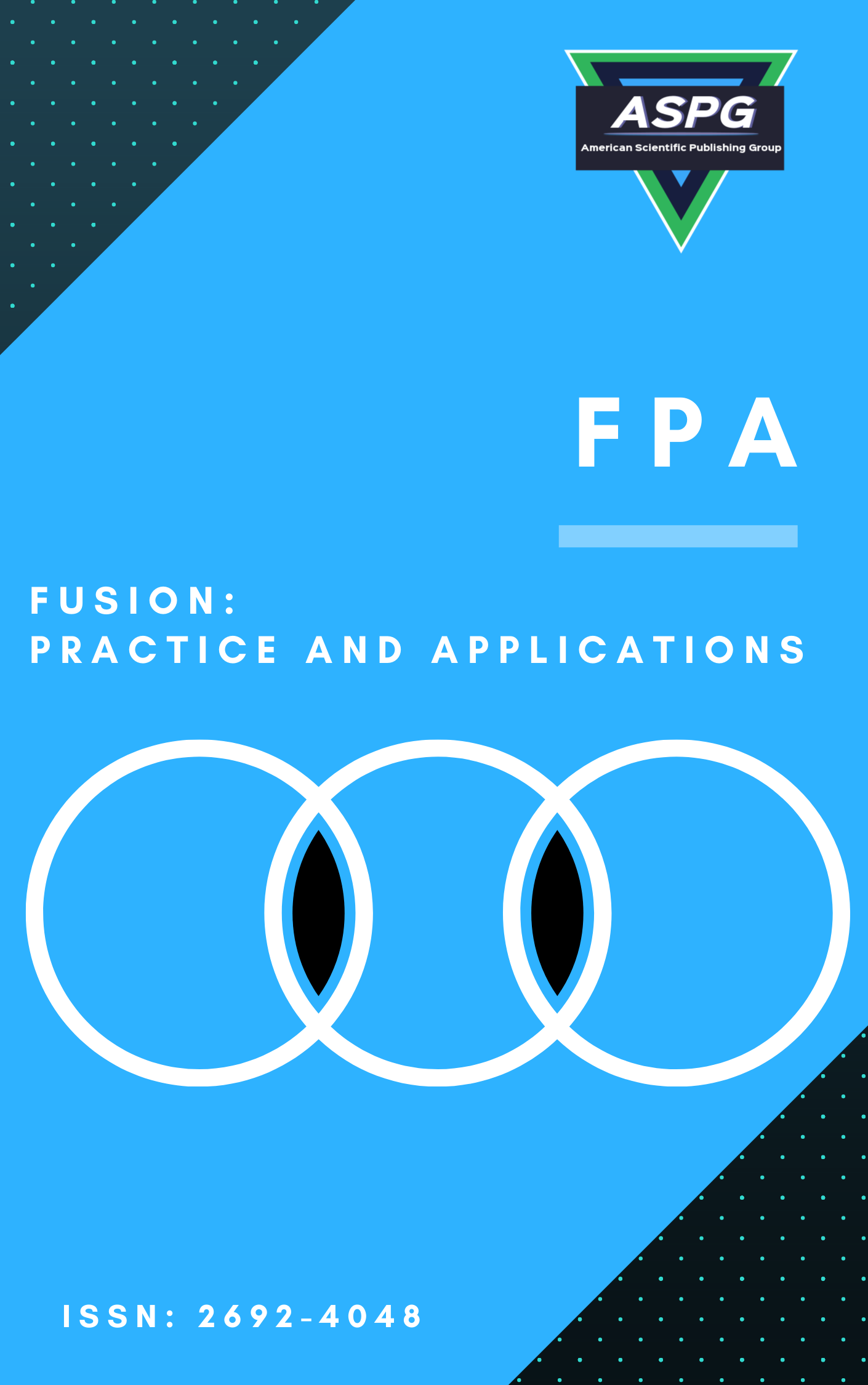

Volume 19 , Issue 2 , PP: 278-287, 2025 | Cite this article as | XML | Html | PDF | Full Length Article
Dalya Anwar 1 *
Doi: https://doi.org/10.54216/FPA.190220
Plant diseases are considered a real threat to food security due to the losses incurred by individuals and countries. Early detection is one of the real solutions that can help reduce the size of these losses, but early detection is still bleeding. This study presents the development of a Convolutional Neural Network (CNN) model for classification with a new architecture and optimal performance suitable for real-time applications for the detection of fruit diseases (figs, oranges, grapes). The developed CNN model balanced accuracy and FLOPs using Squeeze-Excitation (SE) and adaptive-average pool layers. After implementing new data developed from Iraqi farms, the CNN model achieved optimal performance compared to the most famous models such as VGG16, ResNet, EfficientNet, and AlexNet.
Plant Disease Detection , Convolutional Neural Networks (CNN) , Fruit Leaves , Deep Learning in Agriculture , Real-Time Detection
[1] D. Li, F. Ahmed, N. Wu, and A. I. Sethi, “Yolo-JD: A deep learning network for jute diseases and pests detection from images,” Plants, vol. 11, no. 7, p. 937, 2022.
[2] Ramanjot et al., “Plant disease detection and classification: A systematic literature review,” Sensors, vol. 23, no. 10, p. 4769, 2023.
[3] M. K. Agbulos, Y. Sarmiento, and J. Villaverde, “Identification of leaf blast and brown spot diseases on rice leaf with YOLO algorithm,” in Proc. IEEE 7th Int. Conf. Control Sci. Syst. Eng. (ICCSSE), 2021, pp. 307–312.
[4] L. Goel and J. Nagpal, “A systematic review of recent machine learning techniques for plant disease identification and classification,” IETE Tech. Rev., vol. 40, no. 3, pp. 423–439, 2023.
[5] F. Martinelli et al., “Advanced methods of plant disease detection: A review,” Agron. Sustain. Dev., vol. 35, pp. 1–25, 2015.
[6] V. Singh, N. Sharma, and S. Singh, “A review of imaging techniques for plant disease detection,” Artif. Intell. Agric., vol. 4, pp. 229–242, 2020.
[7] C. H. Bock, G. H. Poole, P. E. Parker, and T. R. Gottwald, “Plant disease severity estimated visually, by digital photography and image analysis, and by hyperspectral imaging,” CRC Crit. Rev. Plant Sci., vol. 29, no. 2, pp. 59–107, 2010.
[8] H. Slimani, J. El Mhamdi, and A. Jilbab, “Drone-assisted plant disease identification using artificial intelligence: A critical review,” Int. J. Comput. Digit. Syst., vol. 14, no. 1, pp. 10433–10446, 2023.
[9] Y. Ampatzidis, L. De Bellis, and A. Luvisi, “iPathology: Robotic applications and management of plants and plant diseases,” Sustainability, vol. 9, no. 6, p. 1010, 2017.
[10] A. Bhargava et al., “Plant leaf disease detection, classification and diagnosis using computer vision and artificial intelligence: A review,” IEEE Access, 2024.
[11] S. S. Chouhan, U. P. Singh, and S. Jain, “Applications of computer vision in plant pathology: A survey,” Arch. Comput. Methods Eng., vol. 27, no. 2, pp. 611–632, 2020.
[12] D. I. Patrício and R. Rieder, “Computer vision and artificial intelligence in precision agriculture for grain crops: A systematic review,” Comput. Electron. Agric., vol. 153, pp. 69–81, 2018.
[13] S. Saleki and J. Tahmoresnezhad, “Agry: A comprehensive framework for plant diseases classification via pretrained EfficientNet and convolutional neural networks for precision agriculture,” Multimed. Tools Appl., pp. 1–39, 2024.
[14] R. Chen, H. Qi, Y. Liang, and M. Yang, “Identification of plant leaf diseases by deep learning based on channel attention and channel pruning,” Front. Plant Sci., vol. 13, p. 1023515, 2022.
[15] D. Zhu, Q. Feng, J. Zhang, and W. Yang, “Cotton disease identification method based on pruning,” Front. Plant Sci., vol. 13, p. 1038791, 2022.
[16] R. Wang et al., “Deep neural network compression for plant disease recognition,” Symmetry (Basel)., vol. 13, no. 10, p. 1769, 2021.
[17] F. Rajeena P. P., A. S. U., M. A. Moustafa, and M. A. S. Ali, “Detecting plant disease in corn leaf using EfficientNet architecture—An analytical approach,” Electronics, vol. 12, no. 8, p. 1938, 2023.
[18] R. Desislavov, F. Martínez-Plumed, and J. Hernández-Orallo, “Compute and energy consumption trends in deep learning inference,” arXiv Prepr. arXiv2109.05472, 2021.
[19] O. N. Neamah, T. A. Almohamad, and R. Bayir, “Enhancing road safety: Real-time distracted driver detection using Nvidia Jetson Nano and YOLOv8,” in Proc. Zooming Innov. Consumer Technol. Conf. (ZINC), 2024, pp. 194–198.
[20] S. B. Jadhav, “Convolutional neural networks for leaf image-based plant disease classification,” IAES Int. J. Artif. Intell., vol. 8, no. 4, p. 328, 2019.
[21] S. H. Lee, H. Goëau, P. Bonnet, and A. Joly, “New perspectives on plant disease characterization based on deep learning,” Comput. Electron. Agric., vol. 170, p. 105220, 2020.
[22] M. Islam, A. Dinh, K. Wahid, and P. Bhowmik, “Detection of potato diseases using image segmentation and multiclass support vector machine,” in Proc. IEEE 30th Can. Conf. Electr. Comput. Eng. (CCECE), 2017, pp. 1–4.
[23] Y. Zhang, C. Song, and D. Zhang, “Deep learning-based object detection improvement for tomato disease,” IEEE Access, vol. 8, pp. 56607–56614, 2020.
[24] M. S. Maqbool, R. Nazeer, A. Basit, and K. Zahra, “Automated detection and localization of fungal infections on cotton leaves using YOLO-based object detection model,” Mach. Algorithms, vol. 2, no. 2, pp. 121–136, 2023.
[25] H. Zhou et al., “Automatic detection of rice blast fungus spores by deep learning-based object detection: Models, benchmarks and quantitative analysis,” Agriculture, vol. 14, no. 2, p. 290, 2024.
[26] V.-T. Hoang and K.-H. Jo, “Practical analysis on architecture of EfficientNet,” in Proc. 14th Int. Conf. Human Syst. Interact. (HSI), 2021, pp. 1–4.
[27] T. Shanthi and R. S. Sabeenian, “Modified AlexNet architecture for classification of diabetic retinopathy images,” Comput. Electr. Eng., vol. 76, pp. 56–64, 2019.
[28] S. Mascarenhas and M. Agarwal, “A comparison between VGG16, VGG19 and ResNet50 architecture frameworks for image classification,” in Proc. Int. Conf. Disruptive Technol. Multi-Disciplinary Res. Appl. (CENTCON), 2021, pp. 96–99.
[29] S. Targ, D. Almeida, and K. Lyman, “ResNet in ResNet: Generalizing residual architectures,” arXiv Prepr. arXiv1603.08029, 2016.